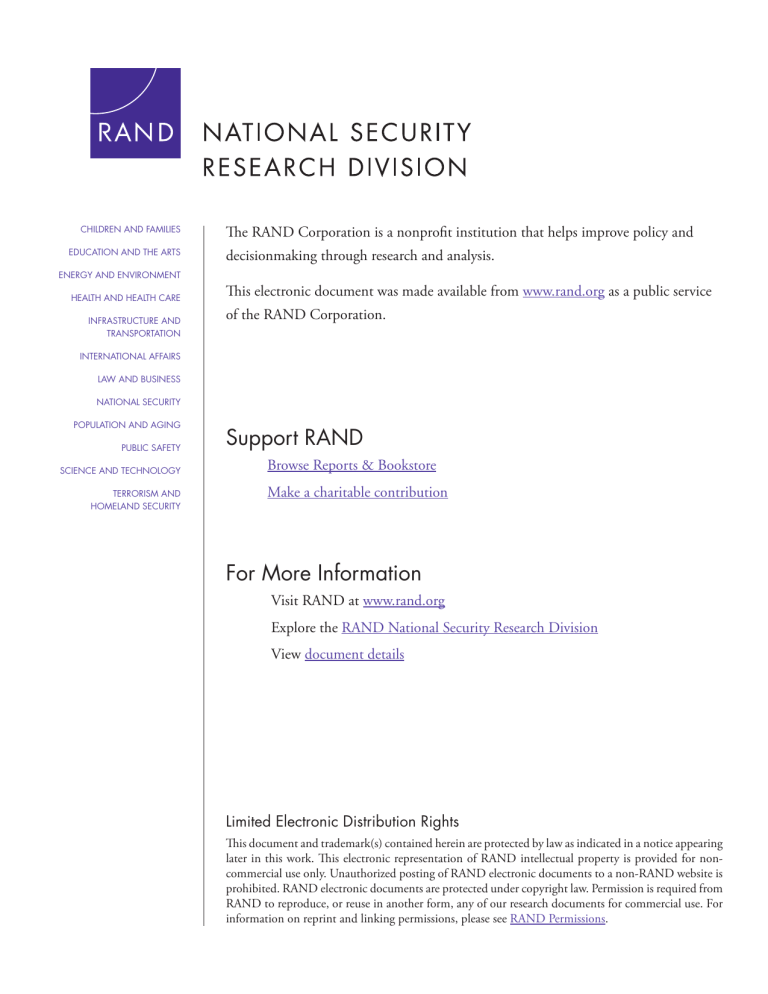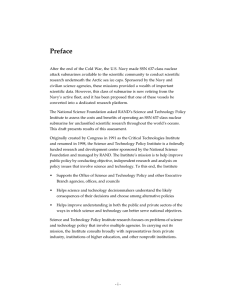The RAND Corporation is a nonprofit institution that helps improve... decisionmaking through research and analysis.
advertisement

CHILDREN AND FAMILIES EDUCATION AND THE ARTS The RAND Corporation is a nonprofit institution that helps improve policy and decisionmaking through research and analysis. ENERGY AND ENVIRONMENT HEALTH AND HEALTH CARE INFRASTRUCTURE AND TRANSPORTATION This electronic document was made available from www.rand.org as a public service of the RAND Corporation. INTERNATIONAL AFFAIRS LAW AND BUSINESS NATIONAL SECURITY POPULATION AND AGING PUBLIC SAFETY SCIENCE AND TECHNOLOGY TERRORISM AND HOMELAND SECURITY Support RAND Browse Reports & Bookstore Make a charitable contribution For More Information Visit RAND at www.rand.org Explore the RAND National Security Research Division View document details Limited Electronic Distribution Rights This document and trademark(s) contained herein are protected by law as indicated in a notice appearing later in this work. This electronic representation of RAND intellectual property is provided for noncommercial use only. Unauthorized posting of RAND electronic documents to a non-RAND website is prohibited. RAND electronic documents are protected under copyright law. Permission is required from RAND to reproduce, or reuse in another form, any of our research documents for commercial use. For information on reprint and linking permissions, please see RAND Permissions. RAND working papers (WRs) are intended to share the authors’ latest research findings and solicit informal peer review. They have been reviewed by the management but typically have not been edited or undergone RAND’s formal technical review process. WORKING P A P E R Struucturin ng Analysis to Sup pport Future e Decisions Abo out Nuclear Forces and Posstures PAUL K K. DAVIS WR-878-O OSD Septembeer 2011 Prepared for the Office of the Secretary of Defense This product is part p of the RAND D National Defensse Research Institute working paper series. s RAND working papers are intended to share researche ers’ latest findingss and to solicit infformal peer revie ew. They have been approved for circulation by RA AND National Defense Researcch Institute but ha ave not been formally edited or peerr reviewed. Unlesss otherwise indiccated, working papers can be quoted and a ermission of the author, cited without pe provided the sou urce is clearly refferred to as a working paper. RAND’s publications do not necessarily reflect the opinio ons of its research clients and spon nsors. is a reg gistered tradema ark. Working Paper STRUCTURING ANALYSIS TO SUPPORT FUTURE DECISIONS ABOUT NUCLEAR FORCES AND POSTURES Paul K. Davis RAND Corporation SMA CANS Project October 5, 2011 SUMMARY This paper is a think piece than looks freshly at how to evaluate future nuclear forces and postures. A fresh look is needed for the New Start era because the role of nuclear weapons in security continues to change—but in ways that are not well understood and have not been much discussed analytically. After reviewing past and present criteria for nuclear assessments, and contrasting enduring stances on such matters by policymakers, I recommend evaluating options for ability to achieve generalized versions of five top-level objectives: strategic stability; crisis stability; ability for the United States to act, defeat, and defend; nonproliferation and other policy goals; and risk control. Here stability relates to avoiding coercion, war, and arms competition generally—not just to nuclear-related issues. Crisis stability relates to both firstaction stability, whether conventional or nuclear, and to subsequent escalation control. Ability to act, defeat, and defend recognizes that in most crises and conflicts the U.S. will want military options and, if war begins, will want to defeat the opponent and defend against opponent actions—even in a hypothetical but imaginable war that included some limited use of nuclear weapons (as in a rogue leader’s last-gasp flailing out to deter the U.S. from defending an ally or overturning a regime). Force-structure/posture options should, of course, be assessed for their contributions to nonproliferation and other foreign-policy goals. Finally, options should be assessed not only for their allegedly likely consequences, but for various risks of worse-thanexpected consequences. Some risks, such as underestimating the deterrent value of an option, can be part of assessing strategic stability and crisis stability. Other risks distinguishing among options relate to implementability and sustainability, military/technical matters such as reliability and survivability, and domestic and international perceptions about the balance of power. It will be important to make the evaluations separately for at least two very different and longstanding strategic perspectives, which differ not only in the relative weight given to the various objectives, but to the objective-by-objective assessments themselves (as in whether, in fact, a given option would improve or worsen proliferation). “Objective analysis” cannot resolve some of these differences, but it can sharpen understanding of agreements and disagreements. An important part of doing so will be to identify vivid stressful test cases relating specifically to nuclear forces and postures in dilemma-ridden situations, and to rethink “how much is enough?” for various nuclear or nuclear/conventional missions in crises or conflicts with multiple nuclear actors. Even if these are “virtual missions” that will not be needed if deterrence succeeds, it is important to know what missions could be accomplished with tens, hundreds, or thousands of arriving nuclear weapons, and what this would mean for total force structure and posture that must allow for failures, vulnerabilities, inflexibilities, and reserves given a world with multiple nuclear powers. Part of such future analysis will be assessing the extent to which conventional military capabilities can substitute for nuclear capabilities and the scenarios in which conventional options would even be plausible—recognizing that U.S. conventional military superiority, when it exists, is highly situation dependent.





